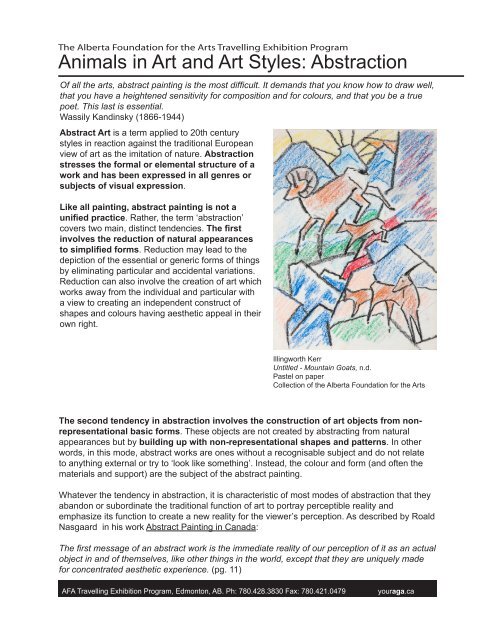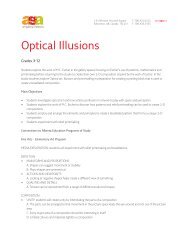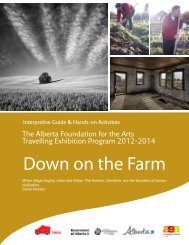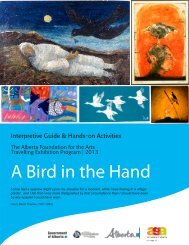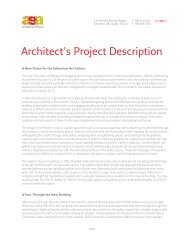Urban Animals - Art Gallery of Alberta
Urban Animals - Art Gallery of Alberta
Urban Animals - Art Gallery of Alberta
Create successful ePaper yourself
Turn your PDF publications into a flip-book with our unique Google optimized e-Paper software.
The <strong>Alberta</strong> Foundation for the <strong>Art</strong>s Travelling Exhibition Program<br />
<strong>Animals</strong> in <strong>Art</strong> and <strong>Art</strong> Styles: Abstraction<br />
Of all the arts, abstract painting is the most difficult. It demands that you know how to draw well,<br />
that you have a heightened sensitivity for composition and for colours, and that you be a true<br />
poet. This last is essential.<br />
Wassily Kandinsky (1866-1944)<br />
Abstract <strong>Art</strong> is a term applied to 20th century<br />
styles in reaction against the traditional European<br />
view <strong>of</strong> art as the imitation <strong>of</strong> nature. Abstraction<br />
stresses the formal or elemental structure <strong>of</strong> a<br />
work and has been expressed in all genres or<br />
subjects <strong>of</strong> visual expression.<br />
Like all painting, abstract painting is not a<br />
unified practice. Rather, the term ‘abstraction’<br />
covers two main, distinct tendencies. The first<br />
involves the reduction <strong>of</strong> natural appearances<br />
to simplified forms. Reduction may lead to the<br />
depiction <strong>of</strong> the essential or generic forms <strong>of</strong> things<br />
by eliminating particular and accidental variations.<br />
Reduction can also involve the creation <strong>of</strong> art which<br />
works away from the individual and particular with<br />
a view to creating an independent construct <strong>of</strong><br />
shapes and colours having aesthetic appeal in their<br />
own right.<br />
Illingworth Kerr<br />
Untitled - Mountain Goats, n.d.<br />
Pastel on paper<br />
Collection <strong>of</strong> the <strong>Alberta</strong> Foundation for the <strong>Art</strong>s<br />
The second tendency in abstraction involves the construction <strong>of</strong> art objects from nonrepresentational<br />
basic forms. These objects are not created by abstracting from natural<br />
appearances but by building up with non-representational shapes and patterns. In other<br />
words, in this mode, abstract works are ones without a recognisable subject and do not relate<br />
to anything external or try to ‘look like something’. Instead, the colour and form (and <strong>of</strong>ten the<br />
materials and support) are the subject <strong>of</strong> the abstract painting.<br />
Whatever the tendency in abstraction, it is characteristic <strong>of</strong> most modes <strong>of</strong> abstraction that they<br />
abandon or subordinate the traditional function <strong>of</strong> art to portray perceptible reality and<br />
emphasize its function to create a new reality for the viewer’s perception. As described by Roald<br />
Nasgaard in his work Abstract Painting in Canada:<br />
The first message <strong>of</strong> an abstract work is the immediate reality <strong>of</strong> our perception <strong>of</strong> it as an actual<br />
object in and <strong>of</strong> themselves, like other things in the world, except that they are uniquely made<br />
for concentrated aesthetic experience. (pg. 11)<br />
AFA Travelling Exhibition Program, Edmonton, AB. Ph: 780.428.3830 Fax: 780.421.0479<br />
youraga.ca


